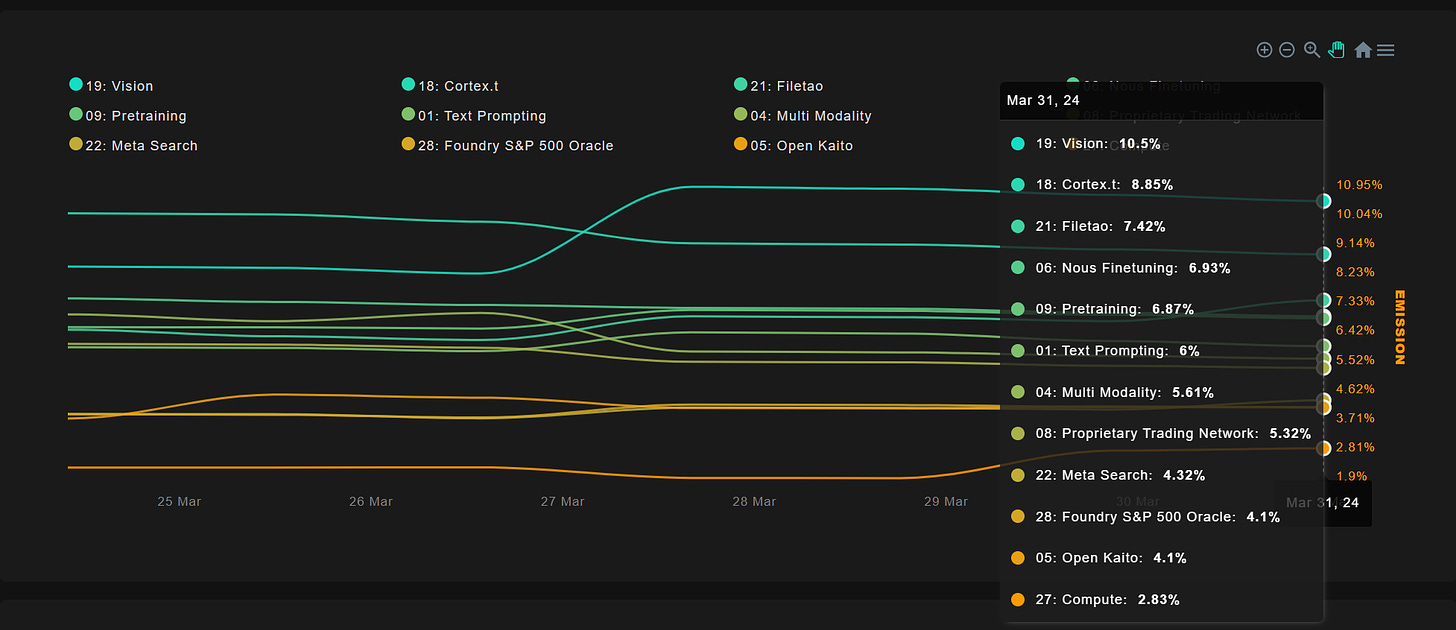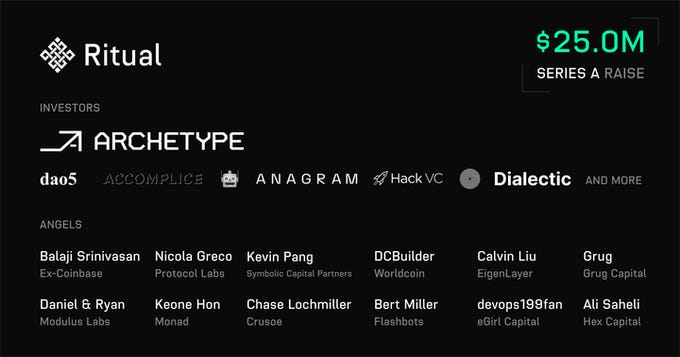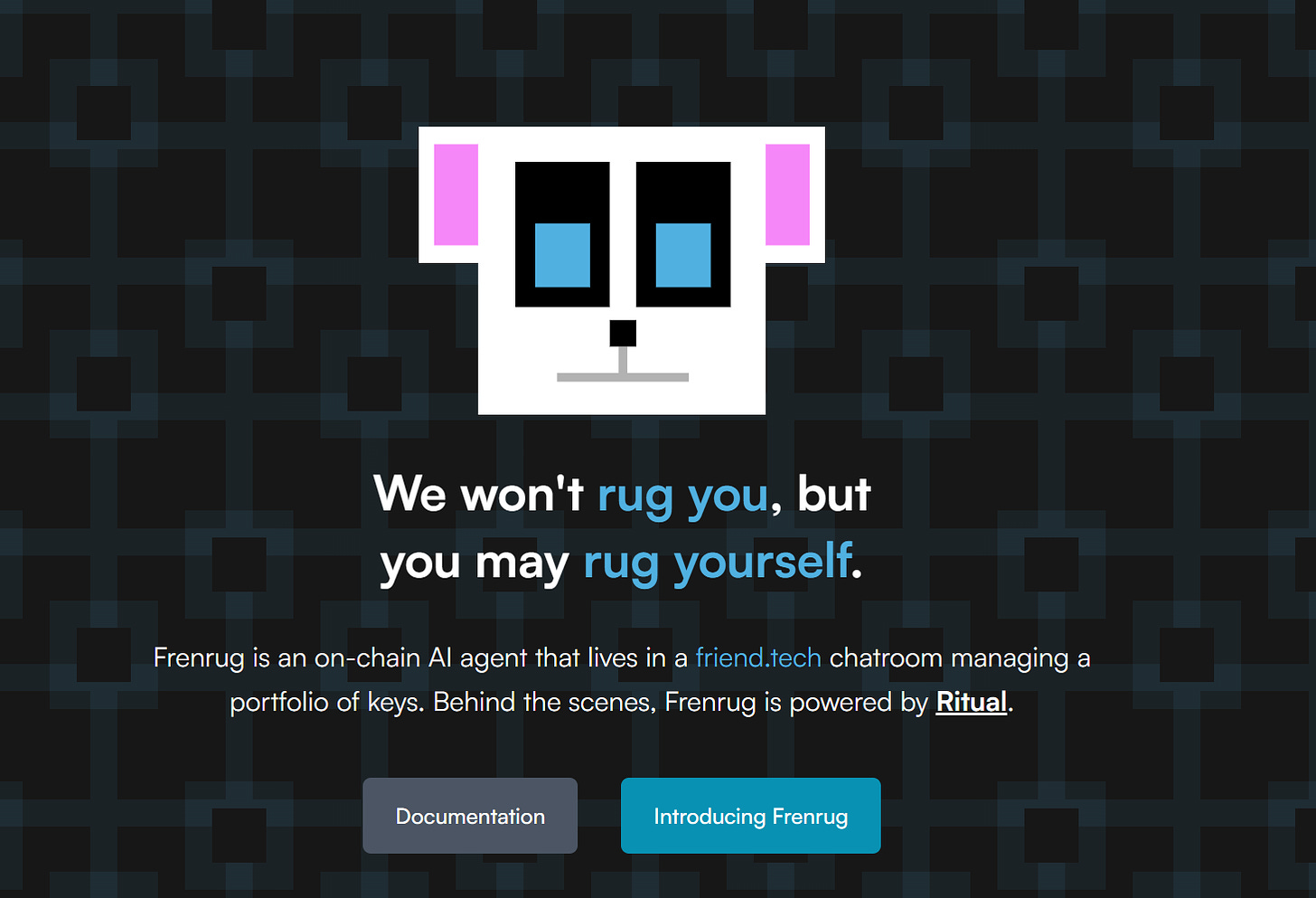In the past year, with the popularization of the concept of decentralized AI and the widespread application of various AI tools, AI + Web3 has gradually become one of the hottest topics in the encryption circle. According to incomplete statistics, there are currently more than 140 projects combining Web3 and AI in the industry, covering multiple directions such as computing, verification, metaverse, and games. Ethereum Lianchuang Vitalik also wrote an article to discuss the use cases of combining blockchain and AI, and pointed out that the cross-field use cases of the two are increasing, and some use cases are of higher significance and robustness. In addition, at the recent Hong Kong Web3 Carnival held in Hong Kong, the topic of the combination of AI and Web3 was frequently mentioned in both the main venue and the side venue.
This article selects three noteworthy Web3 and AI integration projects and discusses their unique positioning and development prospects in the field of encrypted AI.
Bittensor: Leading in market capitalization, but practicality is questioned by the market
In the field of AI, unlike resource-intensive computing power and data, encryption algorithms focus more on technology-intensive work. However, there is a problem in the current AI field, that is, due to the existence of technical barriers, algorithms and models often cannot cooperate effectively, resulting in a zero-sum game situation. In order to change this situation, Bittensor proposed a solution to promote cooperation between different algorithms through the blockchain network and incentive mechanism, and gradually build an algorithm market for shared knowledge. In short, similar to Bitcoins mining network, Bitnsor just replaces the Bitcoin mining calculation process with training and verifying AI models.
Judging from the name, Bittensor can be decomposed into two parts: Bit and Tensor. Among them, Bit is no stranger to us. It can be understood as the smallest currency unit in Bitcoin. In the broader computer science, Bit represents the most basic unit of information. Tensor is derived from the Latin Tendera, which originally means expansion. In physics, a Tensor refers to a tensor with multiple exponents, a multidimensional array or matrix that can represent various types of data. In the field of machine learning, Tensor means used to represent and process multi-dimensional data.
Bittensors architecture can be divided into two layers. The bottom layer is a blockchain based on Polkadot Substrate, which is responsible for executing the consensus mechanism and motivating the network. The AI layer is responsible for reasoning, training, and ensuring input/output compatibility between Bittensor protocol nodes. There are two key participants in the Bittensor network, namely miners and validators. Miners submit training models to the network in exchange for token rewards, while validators are responsible for confirming the validity and accuracy of model outputs and selecting the most accurate outputs to return to users. In order to create a forward competition cycle, Bittensor implements incentive distribution through the Yuma consensus mechanism. The Yuma consensus combines PoW and PoS mechanisms, in which miners obtain token rewards through competitive calculation results, while validators need to pledge their tokens in a certain subnet and complete the verification work to obtain a certain amount of TAO incentives. , the more accurate and consistent the screening and evaluation of AI models, the more rewards you will receive.
Subnets are a core component of the Bittensor ecosystem. In October 2023, Bittensor introduced the concept of Subnet through the Revolution upgrade. Different subnets can be responsible for different tasks, including machine translation, image recognition and generation, language large models, etc. At the same time, these subnets can interact with each other. Interaction and learning. Anyone can create a subnet on Bittensor, but they need to pay a fee in TAO tokens. The amount of the fee depends on the supply and demand of the subnet on the network. In addition, tests need to be run locally and on the testnet before going live on the subnets mainnet.
Currently there is a special subnet 0 # Root and 32 other subnets on Bittensor. 0 # Root is built by the Opentensor Foundation. As the governance center on Bittensor, it can distribute the output TAO to other subnets through consensus. On 0 # Root, the role of validators comes from the top 64 validators with the largest number of pledges on other subnets, and the role of miners is played by other subnets. In addition, 0 # Root can also allocate incentives to other subnets based on their contribution. For the remaining 32 subnets, verification nodes and miners will receive a certain proportion of TAO based on their respective contributions. Typically, 41% is allocated to validators, 41% to miners, and the remaining 18% to subnet creators. Competition between subnets in the Bittensor ecosystem is fierce. Currently, the maximum number of subnets allowed by the system is 32, but there are already more than 200 subnets in the testnet waiting to be registered on the mainnet. Recently, some excellent teams have also registered their own subnets on Bittensor, such as MyShell TTS. According to the subnet registration rules, once the upper limit of the number of subnets is reached, the system will automatically cancel the subnet with the lowest token allocation.
Bittensor has also recently faced questions about its registration fees and practicality. It is reported that the current cost of registering a subnet on Bittensor is 2,078.49 TAO, and on March 1, it reached 10,281 TAO, equivalent to more than 7 million US dollars. And as the price of TAO increases, the registration fee may further increase. And every time a project registers a subnet, the registration fee will double, and if no one registers, the price will be linearly halved within four days. For developers who want to create or participate in subnets, the high registration fees will undoubtedly become a huge burden. In addition, the usefulness of the Bittensor subnet has also been questioned. Most of the 32 subnets are used in low-threshold scenarios such as data sorting and text, image and audio conversion. And among the teams building on Bittensor, no team has more than a dozen full-time members, and most only have 2 to 3 people. Eric Wall, the founder of the Bitcoin Ordinals project Taproot Wizards and the Bitcoin NFT project Quantum Cats, also expressed his views on social platforms, believing that Bittensor is just a meaningless decentralized experiment that does not provide any practicality. Eric Wall pointed out, “Subnet #1 is described as a text prompt service. But in fact, its working mode is very simple. Users send a prompt and miners respond, similar to ChatGPT. Miners participating in this process will receive TAO tokens. coins as a reward. But there is severe redundancy here, because the verifier only checks the similarity of the answers, and if any miners answer is different from others, he does not get the reward. The entire system is extremely inefficient and cannot be effective Verify that the model is actually being run. Additionally, there is no way to interact with the network as a normal user. The entire subnet’s only purpose appears to be internal operations. The process appears to be all about purchasing useless AI tokens for decentralized AI exposure.
Ritual: Super luxurious background blessing, using ZKP for AI model inference training
There are many problems in existing AI stacks, including a lack of guarantees for computational integrity, privacy, and censorship. Additionally, infrastructure hosted by a few centralized companies limits developers and users’ ability to integrate locally, leading to effectiveness issues. In this context, the decentralized AI computing platform Ritual came into being.
The main goal of Ritual is to provide an open and modular sovereign execution layer for artificial intelligence, that is, how to introduce artificial intelligence into EVM, SVM and other virtual machine environments. Simply put, Ritual connects distributed node network computing resources and model creators, allowing creators to host their AI models, while users can add the full inference capabilities of the AI model to their existing workflows in a verifiable manner middle.
The Ritual team has a very strong background. Co-founders Niraj Pant and Akilesh Pott were former general partners of Polychain. In addition, team members also include senior engineers from well-known companies such as Microsoft AI and Facebook Novi, as well as professionals from well-known institutions such as Dragonfly, Protocol Labs, and dYdX. In addition, Ritual’s lineup of advisors is also very impressive, including Sreeram Kannan, founder and partner of EigenLayer, Tarun Chitra, founder and CEO of Gauntlet, and Arthur Hayes, co-founder of BitMEX.
So far, Ritual has completed two rounds of financing. In November 2023, Ritual announced the completion of US$25 million in financing, led by Archetype, including ccomplice, Robot Ventures, dao 5, Accel, Dilectic, Anagram, Avra and Hyperspher, as well as angel investors Coinbase’s former chief technology officer Balaji Srinivasan, and Protocol Labs researcher Nicola Greco, Worldcoin research engineer DC Builder, EigenLayer chief strategy officer Calvin Liu, Monad co-founder Keone Hon, Daniel Shorr and Ryan Cao of AI+Crypto project Modulus Labs participated in the investment. And on April 8, 2024, RitualgetReceived a multi-million dollar investment from Polychain Capital, the specific amount is not yet known.
Currently, Ritual has launched Infernet, a lightweight library that introduces calculations to the chain, allowing smart contract developers to request calculations off-chain through Infernet nodes, and pass calculation results to smart contracts on the chain through Infernet SDK. The Infernet node is a lightweight off-chain client of Infernet. It is mainly responsible for listening to on-chain or off-chain requests and delivering workflow output and optional proofs through on-chain transactions or off-chain APIs. The Infernet SDK is a set of smart contracts that allow users to subscribe to the output of off-chain computing workloads. One of its main use cases is to bring machine learning inference on-chain. Infernet can be deployed on any chain, allowing any protocol and application to be integrated. In addition, Infernet also allows developers to introduce their own proof systems, including Halo 2 verifier and Plonky 3 verifier.
Infernet does not directly perform inference on the chain, but is similar to an oracle system. Requests are issued on the chain, and nodes off the chain execute them and return the responses to the chain. However, this method also has asynchronous problems, that is, developers need to wait on the block after making a request and cannot get an immediate response. Rituals approach is to allow developers to directly perform inference operations in an environment they are familiar with, without caring about where the operations occur. Although these operations are still performed off-chain, by embedding these computing operations in the virtual machine, each node can perform ultra-optimized artificial intelligence operations while running a modified virtual machine. This method can be regarded as a kind of interactive communication, implemented through pre-compilation. The emergence of this method is also the development trend of the blockchain ecosystem.
In terms of specific implementation, through Infernet, developers can delegate computing-intensive operations to off-chain and consume output and optional proofs in smart contracts through on-chain callbacks to circumvent the limitations of the smart contract execution environment. For example, Emily is developing a new NFT collection that allows minters to add new features to NFTs independently. Emily built a minting website and published the signed delegation to an Infernet node running a custom workflow that parsed user input and generated a new image, while the Infernet node sent the final image to on her smart contract.
At the end of 2023, Ritual released an application powered by the Infernet SDKFrenrug. Frenrug is a chatbot running in the Friend.tech chat room. Any user who holds Frenrugs Key can send messages to Frenrug. For example, you can buy or sell the corresponding friend.tech users Key through Frenrug, but Frenrug will not directly process user messages, but will send messages to multiple Infernet nodes, which run different language models. Infernet nodes process user messages and generate votes on the blockchain. When enough nodes vote, the system will aggregate these votes and perform corresponding operations on the blockchain, such as buying or selling Keys. Finally, Frenrug will reply in the chat room with the voting results and final actions of each node, letting the user understand how the system handled their request.
Ritual is currently developing its second product Sovereign Chain Ritual Chain. Although Infernet can be easily integrated into any EVM chain, allowing any protocol to be used. But Ritual still firmly believes that building a chain is necessary because it can build more efficient functions on the core execution layer and consensus layer, and allows users who want to maximize the use of artificial intelligence to bring value to the protocol to realize their Vision. Of course, in order to implement a sovereign chain, Ritual needs to build different types of validators, proof systems and various complex functions, and it needs to be simple enough so that users can easily get started.
Virtual: more interesting and focused on user participation
Unlike Bittensor and Ritual, which interact with various machine models, Virtual Protocol is similar to a decentralized factory focused on creating artificial intelligence characters for various virtual worlds. It focuses more on user participation and integrates human subjective thoughts and social consensus into its vision to promote the development of personalization and immersion. The core idea of Virtual Protocol is that future virtual interactions will be enabled by artificial intelligence and built in a decentralized manner to provide personalized and ultra-immersive experiences. Among them, personalization ensures that every interaction creates a personal connection with the user, making it uniquely relevant. On the other hand, immersion can stimulate the users various senses and create a more realistic experience.
Virtual ecosystem participants include contributors and validators. Contributors can provide various text data, speech data and visual data for the model, whether it is the improvement of existing models or the proposal of new models. This content is reviewed and certified by validators to ensure accuracy and authenticity, and the quality of their contributions is evaluated to ensure it meets the standards set by the Virtual Protocol ecosystem.
New proposal: Anyone can initiate the creation of Genesis Virtual, but they need to pledge at least 100,000 VIRTUAL within the specified three months and pass the DAO proposal process. All token holders in the Virtual community can vote on this proposal. Once the proposal passes, a new Virtual NFT is minted.
Contribute to existing models: Proposals are automatically generated, and validators review, discuss, verify, and vote on whether to make changes.
Currently, only validators have the right to verify or vote on proposals, and the entire verification process is conducted anonymously. The verifier needs to interact with each pair of models for at least 10 rounds. After completing the verification task, the verifier can receive a staking reward corresponding to the proportion of the total staking it represents. If you want to become a validator, a user must hold 1,000 Virtual tokens in a Virtual account and commit to verifying all proposals. In addition, Virtual uses the DPos mechanism. If you want to obtain staking rewards without verification, you can choose to entrust any amount of tokens to Virtual verifiers. The verifier will return the staking rewards after deducting 10% of the income ratio. to the entrusting user.
Virtuals entire participation process is transparent and recorded through the public blockchain, and all contributions will be converted into NFTs and stored in the Immutable Contribution Vault (ICV) to ensure their traceability and fair distribution of rewards. The Immutable Contribution Library (ICV) is Virtuals multi-layer on-chain repository, which archives all Virtual-approved contributions on the chain. It can present the current status of each Virtual and track its historical evolution. In addition, ICV creates a transparent environment through the open source VIRTUALs code base model. It promotes composability, allowing developers and contributors to build on top of and seamlessly integrate with existing VIRTUALs.
Virtual token is the core of the Virtual protocol. Its main functions include rewarding contributors and verifiers, supporting protocol development and conducting airdrops. The total supply of Virtual tokens is 1 billion, of which 60% has been publicly circulated, 5% is reserved as a liquidity pool, and the remaining 35% is dedicated to community incentives and initiatives to develop the Virtual protocol ecosystem. In the next three years, the annual release volume will not exceed 10%, and deployment must be approved by the management department.
The Virtual protocol enables flywheel drive through revenue and incentives. Revenue comes from the use of various dApps, and dApps need to pay usage fees to the protocol. At the end of each month, the Virtual Protocol will distribute incentives based on the total revenue inflow of dApps, of which 10% will be allocated to the protocol, and the remaining 90% will be distributed among various Virtual applications according to the pledge ratio to ensure that the revenue is proportional to their contribution. For example: total incoming revenue is $100, of which $10 will be allocated to the protocol. Of the remaining $90, the Virtual A pledge pool holds 9,000 tokens, while the Virtual B pledge pool only holds 1,000 tokens. Then Virtual A will receive 90* 90% = $81, while Virtual B will receive 90* 10% = $9.
In each Virtual application, revenue will be distributed equally among validators and contributors. Validators will earn income based on running time and stake amount, where running time refers to the ratio of the number of verified proposals to the total amount of proposals. For example, if validator A in Virtual A runs 90% of the time, it will receive 81/2* 90% = $36.45. The income will then be further distributed to each pledger, and the specific distribution will be based on the quota. In addition, a default 10% will be paid to the pools validators as delegation fees. Contributors are allocated income based on contribution utilization and impact pool. Among them, the contribution utilization rate takes into account the length of time the contributors contribution has been actively used in the system. Contributors who develop and maintain the model will receive 30% of the total allocated revenue, while users who provide and maintain the datasets used for model fine-tuning will receive 30% of the total allocated revenue. Will receive 70% of total distributed income. Additionally, the Impact Pool awards points based on the importance of the contribution.
Currently, Virtual has access to a software calledAI WaifuIn the virtual companion game. The story background of the game takes place in the world called Arcadia. In the game, you, as a magician in Arcadia, need to fight against other magicians and their Waifus. You can choose to have conversations with your Waifu to deepen your connection, unlock hidden stories, and get even more rewards by giving them gifts. Currently, there are three different Waifu to choose from in the game, each with a unique background story and personality. In addition, the game also introduces a battle mode where you can seduce other Waifus and protect your own Waifu. All in-game expenditures will go into the games reward pool, and 60% of WAI transaction fees will also be distributed as part of the reward pool.
Unlike other AI companions and chatbots, AI Waifu is visually presented as a 3D model and can react emotionally and animatedly to sounds and text. Through communication with AI Waifu, she will not repeat the content style, but will continue to learn and give players personalized responses. Additionally, AI Waifu is a cross-platform PWA with a crypto-enabled economic design that allows for co-ownership and rewards developers with their spending as revenue share.
In addition to AI Waifu, Virtual also plans toroll outA new type of AI RPG with cross-game memory and eventual consciousness, these AI agents are able to dynamically evolve through interaction with players and other agents within the game. That is, the user can put the agent into game A for training and retain the training memory. Later, when the agent is placed in Game B, the memory from Game A remains. Through continuous learning, AI agents can imitate the behavior of human players and can be dynamically constructed based on player behavior and changes in the game environment. This can make the users gaming experience richer, more personalized, and even unpredictable. Users can also upload interaction records and receive token rewards. In addition, Virtual also plans to launch virtual idols that can be broadcast live on any platform.
Summarize
In the field of encrypted AI, Bittensor, Ritual and Virtual Protocol are deeply involved in different fields. Among them, Bittensor is committed to building an algorithm market for sharing knowledge, and its market value currently occupies a leading position in the field of encrypted AI. However, community members have recently raised some questions about the cost and usefulness of its subnet registration. However, whether the problems of a single subnet can be attributed to defects in the entire network needs further evaluation. In addition, regarding the problem that the system relies heavily on verifiers to run, Opentensor Foundation contributors have recently proposed a dynamic TAO solution BIT 001.
With its strong financing lineup and team background, Ritual has become an upstart player in the crypto AI track. Previously, Dragonfly partner Haseeb Qureshi stated in an article that the cryptoeconomics used by Rutial are the simplest and possibly the cheapest in the verifiable inference track, but there are security issues with node collusion. But then Ritual Lianchuang explained on the social platform,expressRather than taking a cryptoeconomic approach based on node cooperation and selective collusion, the Ritual platform provides users with the option to choose a level of security based on their preferences.
In contrast, Virtual Protocol is more fun and focused on user engagement. For example, the protocol launched the AI Waifu virtual companion game and is about to launch an AI agent for games. Compared with the established game rules of traditional games, Virtual Protocol is committed to establishing interactive relationships with players, and hopes to dynamically evolve based on player behavior and the game environment, thereby increasing the social attributes and continuity of the game.
Of course, in addition to the three projects mentioned in this article, there are many Crypto AI projects on the market worthy of attention, such as io.net focusing on the GPU rental market, the AI agency protocol Autonolas, and the Web3-enabled AI platform focusing on creators MyShell etc. These projects demonstrate the diversity and potential of the Crypto AI field, and we will continue to pay close attention to the development of this field.
















